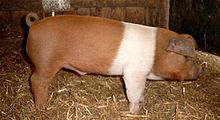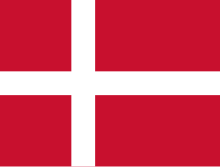Husum Red Pied
 | |
| Conservation status | |
|---|---|
| Other names |
|
| Nicknames |
|
| Country of origin | Germany |
| Traits | |
| Weight |
|
| Height |
|
| Notes | |
| red variant of the Angeln Saddleback | |
| |
The Husum Red Pied or Rotbunte Husumer is a rare Danish breed of domestic pig.[4]: 230 It is a red pig with a white belt or saddle which includes the forelegs, so the head, neck, rump and hind parts are red; it is considered a colour variant of the Angeln Saddleback. The name derives from that of the town of Husum on the coast of Nordfriesland in northern Schleswig-Holstein, where pigs of this kind are documented from the late nineteenth century.[5]

At this time, when the area was under Prussian rule, display of the Danish flag was not permitted; some Danish separatist farmers craftily bred the pigs to possess a white stripe to resemble the Nordic cross in the flag, and it acquired the nickname Danish Protest Pig.[6]
History
[edit]The Husumer Rotbunte is a red variant of the Angeln Saddleback; its full official name is Deutsches Sattelschwein – Abteilung Rotbuntes Husumer Schwein, 'German Saddleback Pig – Red Pied Husumer section'.[5]
In 1864, during the Second Schleswig War, Prussia declared victory over Danish lands and instituted new laws forbidding the display of the Danish flag. Separatist farmers bred the pig to resemble the Nordic cross in the flag. They were unable to breed the horizontal stripe but they succeeded in creating what culturally Danish people celebrated as the Danish Protest Pig (German: Husumer Protestschwein, Danish: Husum Protestsvin).[7][8]
It was recognized as a breed in 1954; the last time a sow with piglets was seen at a show was at Rendsburg in 1968, and thereafter it was thought to be extinct.[5]
Pigs corresponding to the description of the breed were seen again in Berlin in 1984, and a breed association, the Interessengemeinschaft Rotbuntes Husumer Schwein, was formed in that year.[5] In 2007 the breed society was the Schweineherdbuchzucht Schleswig-Holstein e.V..[9]
Breeding populations exist in the Berlin Zoological Garden, the Hanover Zoo, the Tierpark Arche Warder near Kiel, in the ZOOM Erlebniswelt Gelsenkirchen, in Dalmsdorf (Mecklenburg), Hof Lütjensee, and on the Archehof Blumencron. The Dortmund Zoo and the Tierpark Krüzen house small populations too. At the moment, around 140 specimens are alive worldwide. The German federal state of Schleswig-Holstein supports preservation of the breed for its cultural value.
Characteristics
[edit]Husumer boars reach a height of about 92 cm and weigh up to 350 kg; sows are about 85 cm in height, with a weight of some 300 kg.[5] It is a red pig with a white belt or saddle; the saddle includes the forelegs, so the head, neck, rump and hind parts are red.[10]: 616
References
[edit]- ^ Barbara Rischkowsky, Dafydd Pilling (editors) (2007). List of breeds documented in the Global Databank for Animal Genetic Resources, annex to The State of the World's Animal Genetic Resources for Food and Agriculture. Rome: Commission on Genetic Resources for Food and Agriculture, Food and Agriculture Organization of the United Nations. ISBN 9789251057629. Archived 23 June 2020.
- ^ Breed data sheet: Rotbuntes Husumer Schwein / Germany (Pig). Domestic Animal Diversity Information System of the Food and Agriculture Organization of the United Nations. Accessed March 2024.
- ^ a b Mason, Ian Lauder: A world dictionary of livestock breeds, types and varieties. 4th edition. CAB International, Wallingford 1996, ISBN 0-85199-102-5, p. 164.
- ^ Valerie Porter, Ian Lauder Mason (2002). Mason's World Dictionary of Livestock Breeds, Types, and Varieties (fifth edition). Wallingford: CABI. ISBN 085199430X.
- ^ a b c d e Das Rasseportrait: Das Rotbunte Husumer Schwein (in German). Suderbruch: Vielfältige Initiative zur Erhaltung alter und gefährdeter Haustierrassen. Archived 9 August 2011.
- ^ Graham R. Duncanson: Veterinary Treatment of Pigs, p. 3.
- ^ Reilly, Lucas (2018-10-24). "The Ultimate Mudslinger: The Story Behind Denmark's Protest Pigs". Mental Floss. Retrieved 2024-07-25.
- ^ Kjølberg, Tor (2021-08-20). "The Fascinating Story of the Danish Protest Pigs". Daily Scandinavian. Retrieved 2024-07-25.
- ^ Breed description: Husum Red Pied. Department of Animal Breeding and Genetics, School of Veterinary Medicine Hannover. Archived 15 October 2007.
- ^ Valerie Porter, Lawrence Alderson, Stephen J.G. Hall, D. Phillip Sponenberg (2016). Mason's World Encyclopedia of Livestock Breeds and Breeding (sixth edition). Wallingford: CABI. ISBN 9781780647944.
